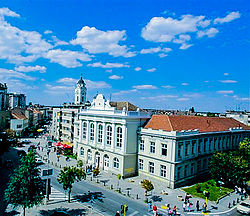Semendria
|
Smederevo Град Смедерево |
||
|---|---|---|
| City | ||
| City of Smederevo | ||
 |
||
|
||
 Location of the city of Smederevo within Serbia |
||
| Coordinates: 44°40′N 20°56′E / 44.667°N 20.933°ECoordinates: 44°40′N 20°56′E / 44.667°N 20.933°E | ||
| Country |
|
|
| Region | Southern and Eastern Serbia | |
| District | Podunavlje | |
| Settlements | 28 | |
| Government | ||
| • Mayor | Jasna Avramović (PZS) | |
| Area | ||
| • Administrative | 484 km2 (187 sq mi) | |
| Population (2011 census) | ||
| • Rank | 13th | |
| • Urban | 64,175 | |
| • Administrative | 108,209 | |
| Time zone | CET (UTC+1) | |
| • Summer (DST) | CEST (UTC+2) | |
| Postal code | 11300 11303 11304 11305 11330 |
|
| Area code | +381(0)26 | |
| Car plates | SD | |
| Website | www |
|
Smederevo (Serbian Cyrillic: Смедерево, pronounced [smêderevo]) is a city and the administrative center of the Podunavlje District in eastern Serbia. It is situated on the right bank of the Danube, about 45 kilometres (28 miles) downstream of the capital, Belgrade.
According to official results of the 2011 census, the city has a population of 64,105, and 108,209 people live in its administrative area.
Its history starts in the 1st century BC, with the conquerings of the Roman Empire, when there existed a town called Vinceia. The modern city traces its roots back to the late Middle Ages when it was the capital (1430–39, and 1444–59) of the last independent Serbian state before the Ottoman conquest.
In Serbian, the city is known as Smederevo (Смедерево), in Latin, Italian, Romanian and Greek as Semendria, in Hungarian as Szendrő or Vég-Szendrő, in Turkish as Semendire.
The name of Smederevo was first recorded in the Charter of the Byzantine Emperor Basil II from 1019, in the part related to the Eparchy of Braničevo (a suffragan diocese of the Archdiocese of Ochrid. Another written record is found in the Charter of Duke Lazar of Serbia from 1381, by which he bestowed the Monastery of Ravanica and villages and properties ’to the Great Bogosav with the commune and heritage’’.
...
Wikipedia

